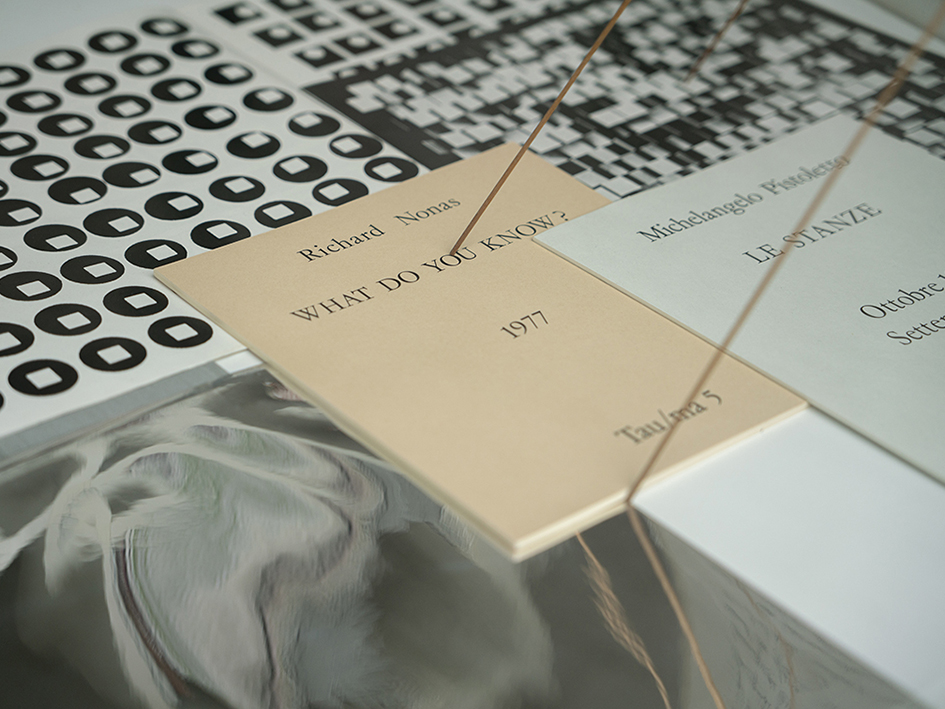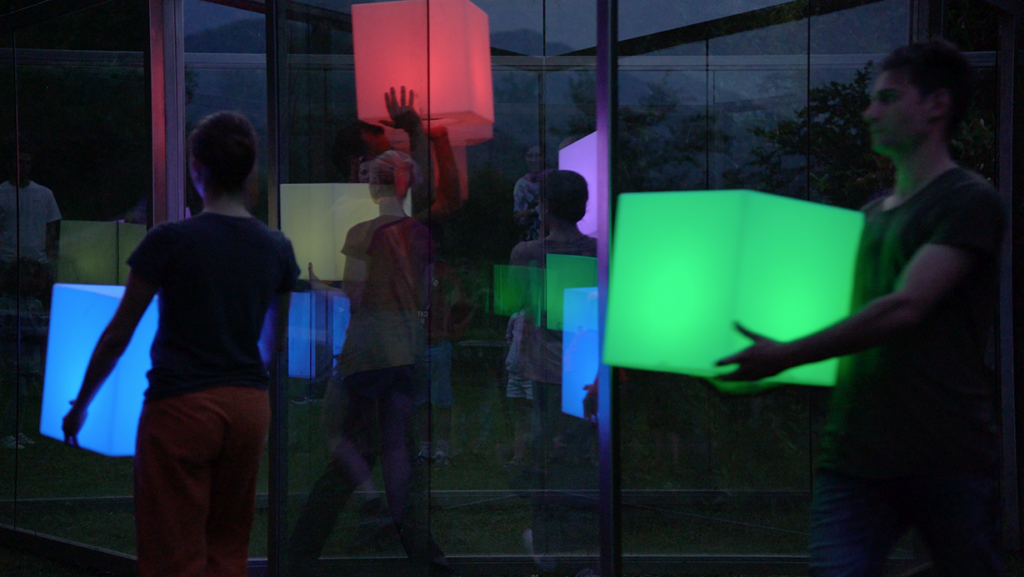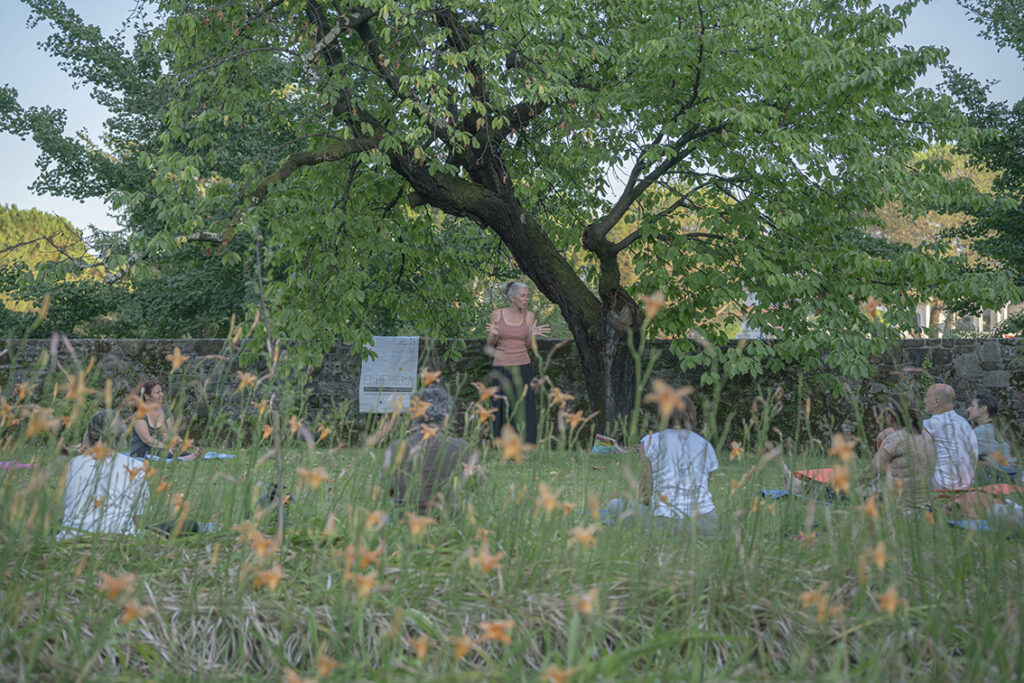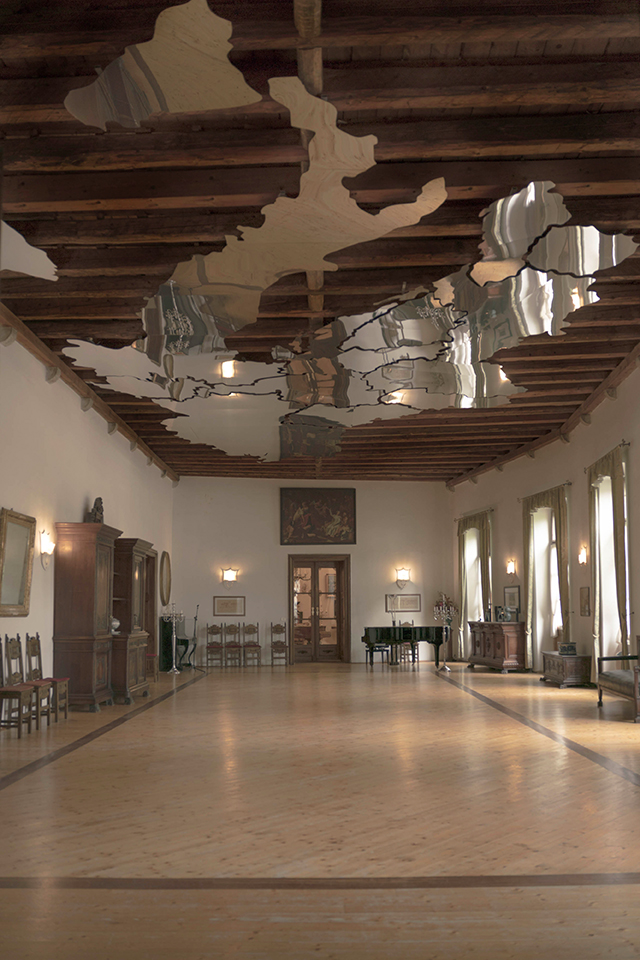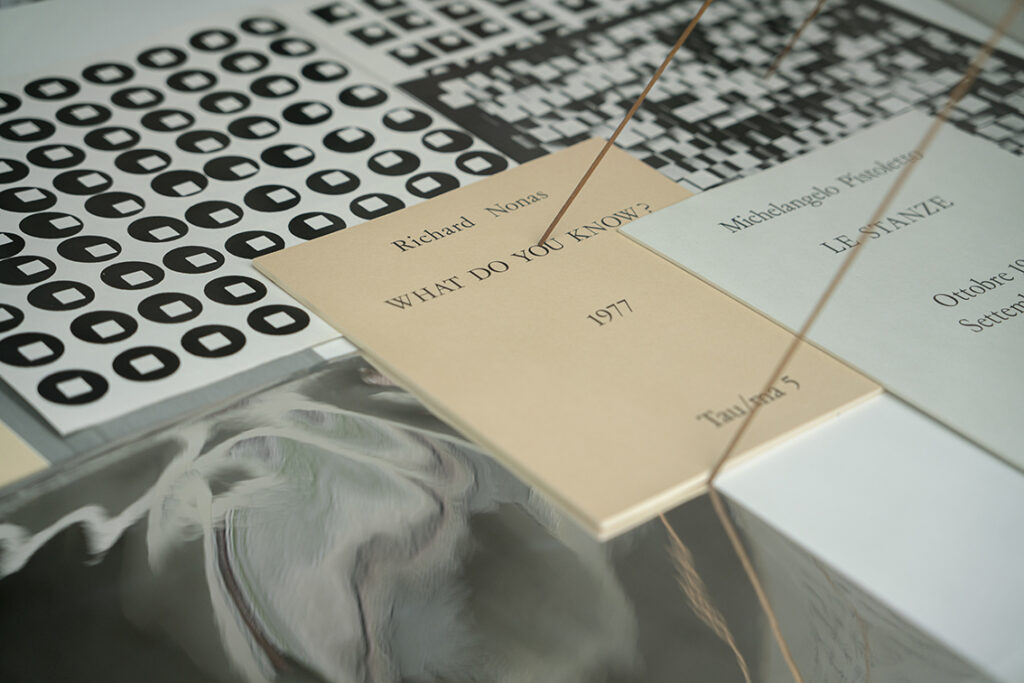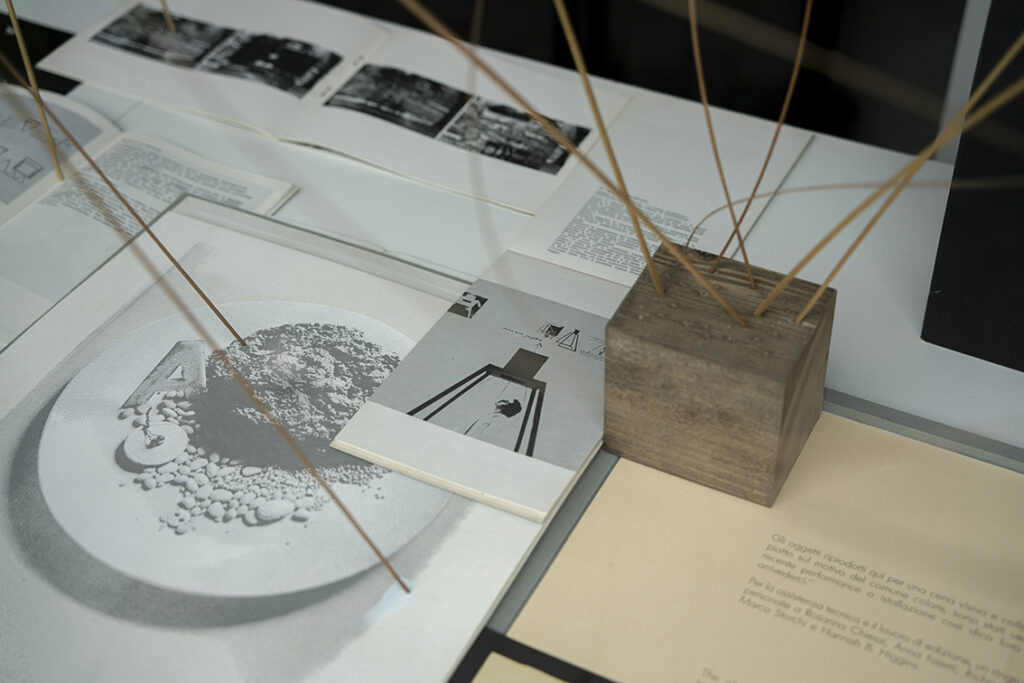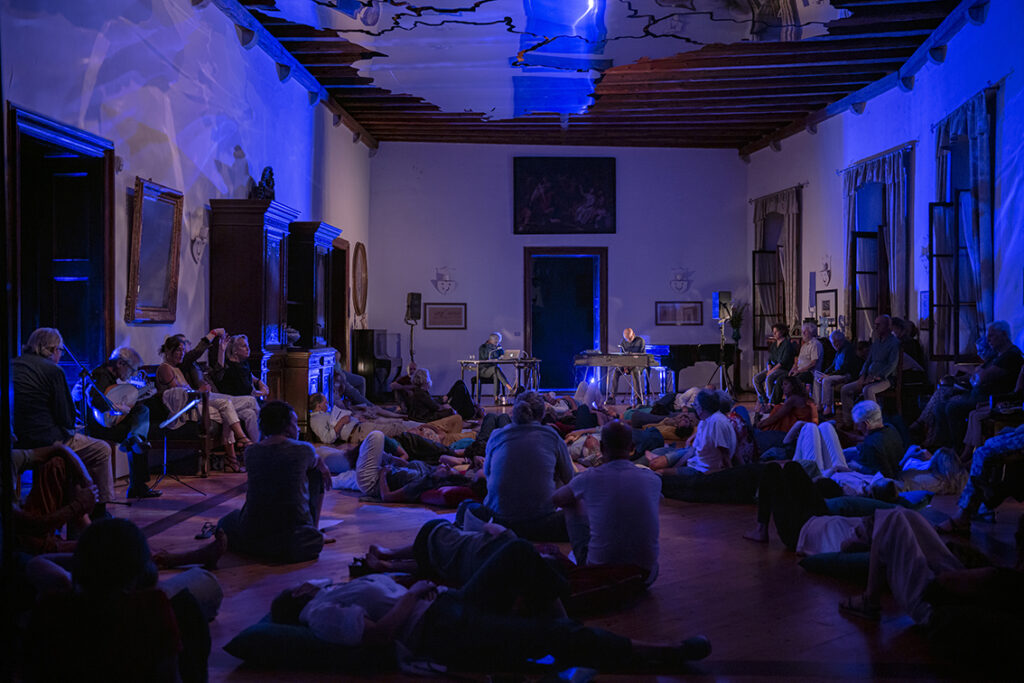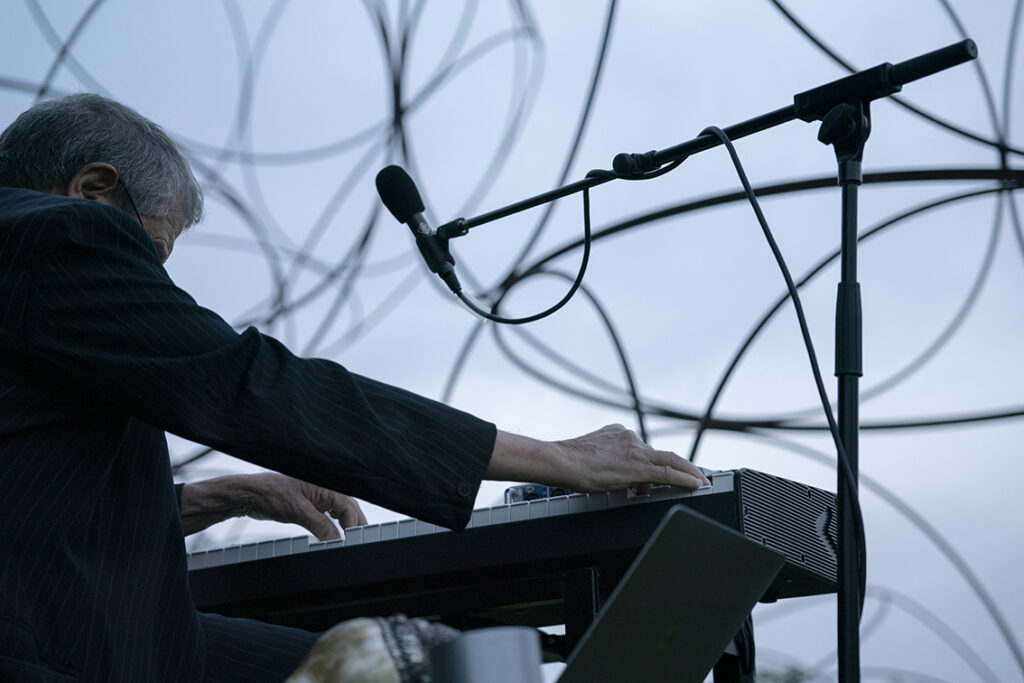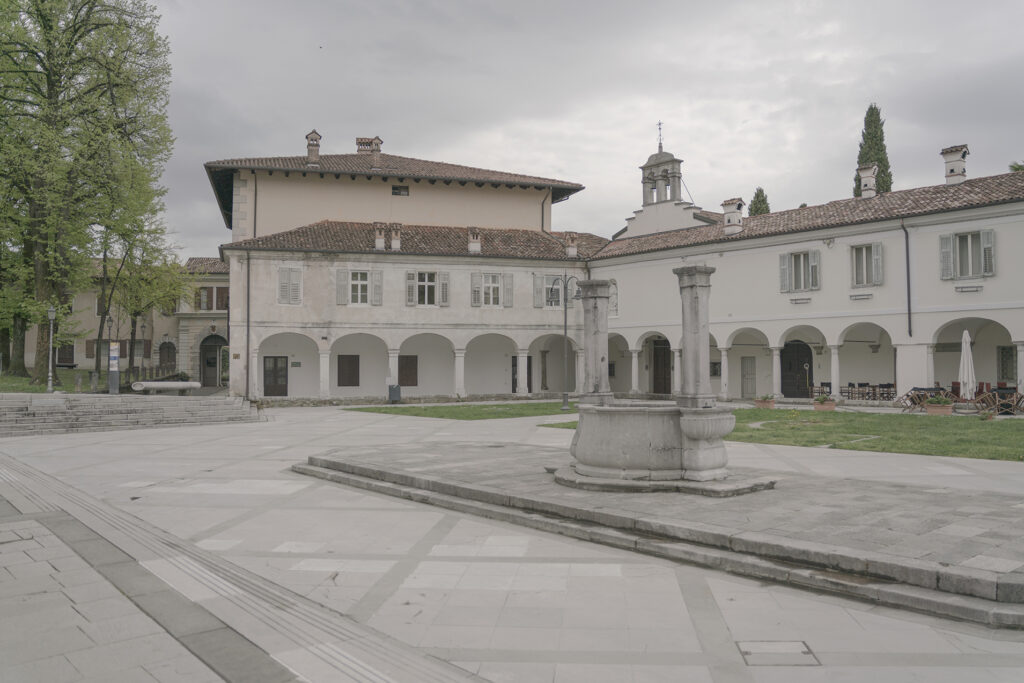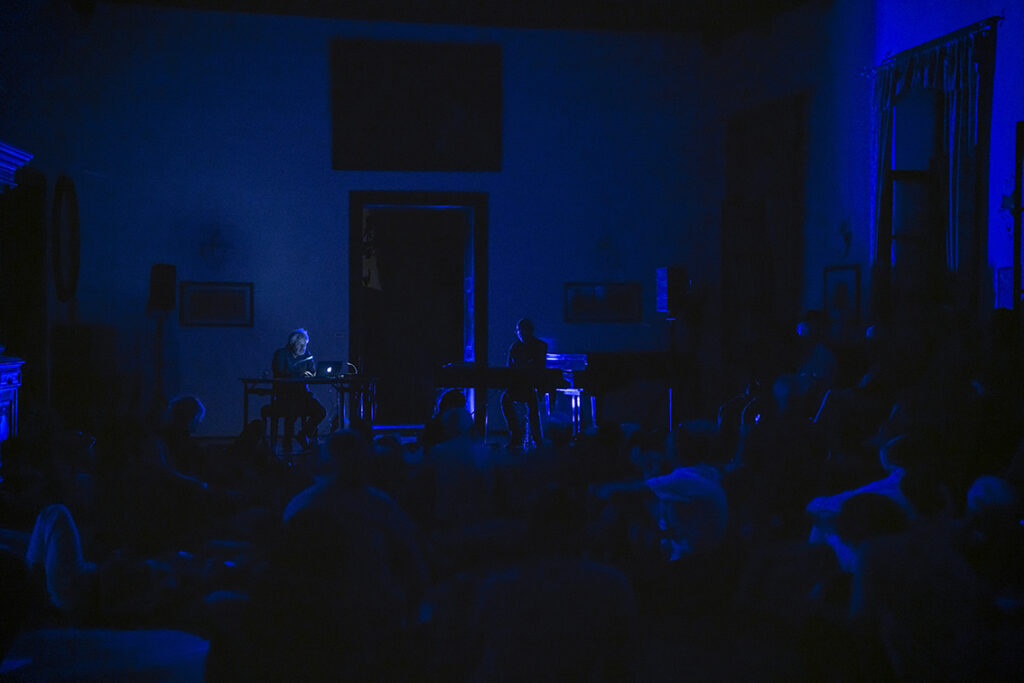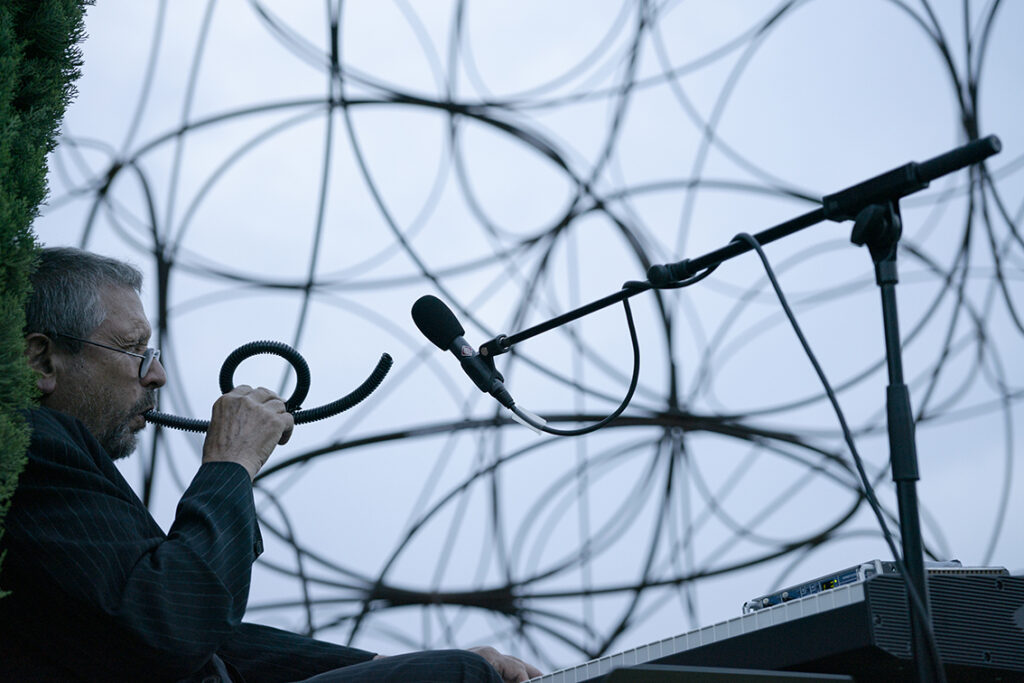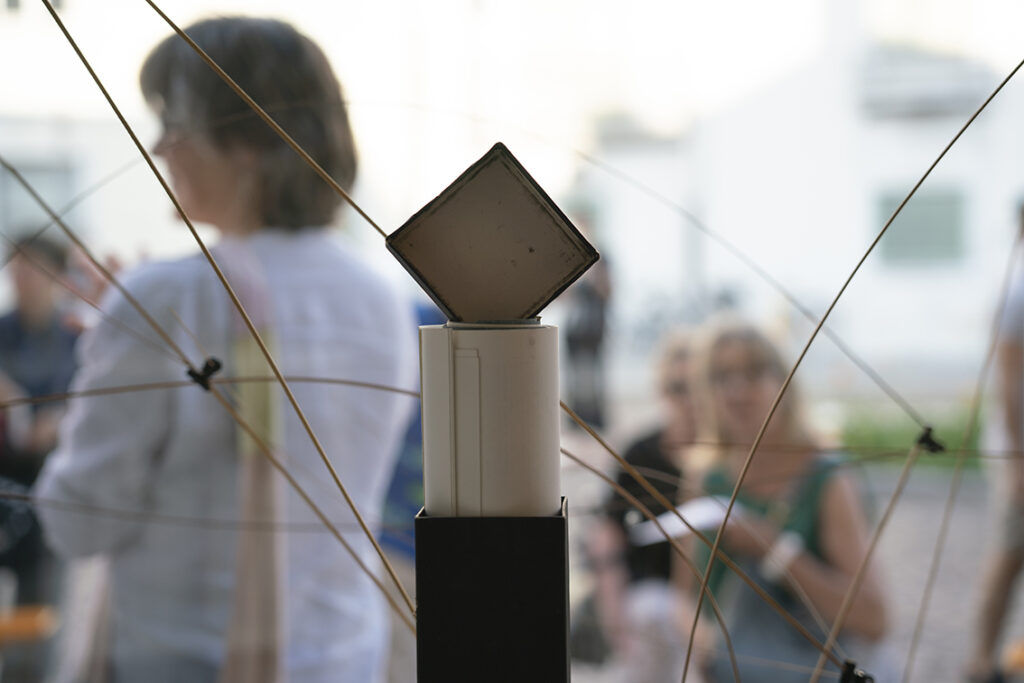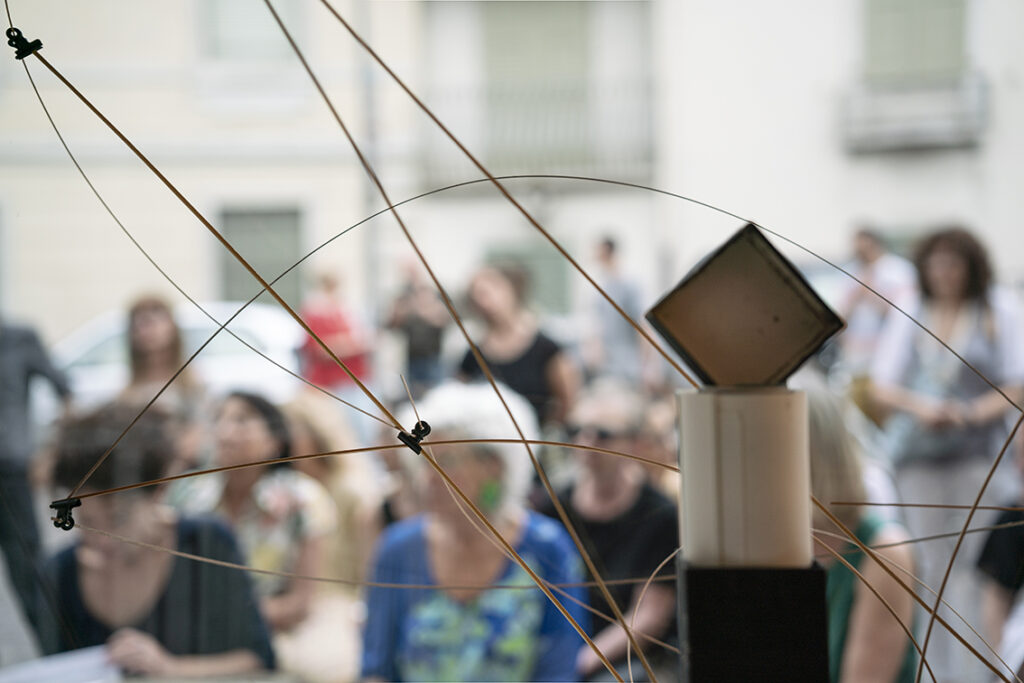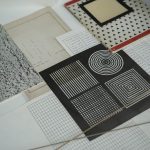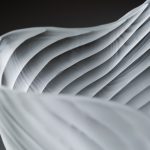Ephemera experiences an apparently unusual union, but one in reality rich in meaning and coherence, linking activities related to the body and movement to the performing arts. Where does this need come from?
The cornerstone of the curatorial project has to do with the strength — as mysterious and intangible as it is evident — of presence. Activating wonder, offering a collective and respectful enjoyment is a necessary cultural act. Presence is a corpus founded in wonder – the important meetings located in festival sites and the land that hosts them, historical and natural.
Presence is a corpus founded in wonder – the important meetings located in festival sites and the land that hosts them, historical and natural.
- ph. Caterina Erica Shanta
We have chosen places that preserve important meetings of absolute worth which, however, share in common the desire to “be lived” not to “be looked at”. Offering an original site-specific performative production for each of these places makes clear the need for the presence of the artist as well as of the public. Body awareness — both being and movement — in relation to diffuse cultural heritage is a cultural act.
We were interested in showing and getting to know places that already host contemporary art collections. Places therefore that it was not necessary to “fill” with “physical objects” (exhibitions, works of art, installations, etc) but rather to switch on and activate. We considered the performing arts because these, by definition, directly involve the body and the direct experience – both physical and sensory — of the viewer.
- ph. Caterina Erica Shanta
Let’s not forget that sport, just as much as art, is a cultural and social device.
First and foremost, the shared experience between people co-present in a place is called into question; the workshops on offer, just as much as the performative events, promote an active and synaesthetic fruition (or one that examines the different senses), that would generate greater self-awareness and a connection between body and mind and with the surrounding environment. For example, just like a contemporary dance performance, the Feldenkrais lessons among the works of the Prato d’Arte Marzona in Verzegnis have incorporated the sounds and scents of nature, the tactile sensation of the lawn, light and sight into the experience of the natural landscape, the acquired awareness of that artistic heritage.
Furthermore, the selected sports disciplines, if on the one hand they are accessible to all in terms of usability, on the other hand they are still a novelty from the regional perspective, and our proposal was an opportunity for many people to experiment and take a closer look.
- ph. Caterina Erica Shanta
After the staging of the first chapter of Ephemera 2022, the events presented at the Prato d’Arte Marzona, at the Vigne Museum and at Palazzo Lantieri seem to tend or want to intertwine the performance with the ‘happening’ by establishing the “active” emotive and emotional participation of the viewer. In this light, the sessions of walking, the Feldenkrais method, yoga acquire their own value as anticipatory and preparatory moments for artistic performances.
If so, has the choice been incorporated correctly or does it take more time for the two areas to integrate their process of working alongside each other?
We have tried to offer activities that are as inclusive as they are uncommon in order to investigate and experience engagement together with new awareness. We are deeply convinced of the cultural value that sport has, both in a broad sense and specifically in terms of relationship and somatic awareness, especially today. We have relied on well-known and inclusive practices – primarily yoga, which, not surprisingly, has recently been recognized by UNESCO as an Intangible Heritage of Humanity – but also to lesser known suggestions deeply linked to the search for somatic awareness – such as the Feldenkrais Method and ChiRunning. We are proud that this suggestion was able to tap into a truly crossover audience – from kids to over 80s – and we have chosen to entrust the guidance of the workshops to teachers with long experience in somatic disciplines but with solid roots relating to the performing arts. The road is long, first and foremost for us. We must have the courage to carry this idea forward to the end, additionally enhancing the depth and the curatorial vision for the suggestions linked to somatic disciplines. For future editions it would be nice to make this effort explicit; once certain of the validity of this combination we can work to integrate and merge the two experiences, or the participants in the two sectors.
- ph. Caterina Erica Shanta
As regards this first edition, the workshop activities have certainly allowed us to introduce the themes of the Festival, its places and its contents to a different, varied and very heterogeneous audience. In some cases the participants of one workshop then decided to stay for the next one, as for the Yoga and Feldenkrais sessions at Parco della Persiana in Palazzo Lantieri. In other cases, however, the opposite happened: participation in a performative event led people to follow us on subsequent dates of the Festival: for example a couple, after having participated in the dance performance event at Prato d’Arte, followed us on all subsequent dates, taking part in both the workshops and other performative events.
Thanks to this, and the enthusiasm seen in people’s faces, we believe that our curatorial management is heading in the right direction, as is the planned programme. This was well received, especially taking into account the high number of participants we had at the various workshops which, in all cases, sold out. And, moreover, it was also true for the three performances.
Thanks to this, and the enthusiasm seen in people’s faces, we believe that our curatorial management is heading in the right direction, as is the planned programme.
- ph. Caterina Erica Shanta
Certainly, however, it is undeniable that these are long processes in which physical activity must be combined, either before or after moments of comparison, explanation and contextualisation. However, this is also true in reverse: we realized that there were times, for example, when we spoke about the various sports workshop activities to the audience at our events.
- ph. Caterina Erica Shanta
At first glance, the locations of Ephemera have a strong charge of energy. Places where architectural and artistic installations are in open dialogue with nature, the land, the elements. An added value for the performance itself.
How did you choose the locations?
Are there other places in Friuli Venezia Giulia that have endowed the same sense of awe to you and that we will see in the future of Ephemera?
The choice of locations was made in a simple and very natural way, without particular difficulties, combining well-known institutions that hosted extraordinary collections of contemporary art within them. From a curatorial point of view, Ephemera was conceived starting from these five places and, for each of them, we have imagined an ad hoc and site-specific artistic offering, using the characteristics of each site as a starting-point. The choice of artists took into account both the particular historical impact of the places – for example, the idea of involving a personality like Alvin Curran was born from here, whose creative path spanning almost sixty years of experimentation is closely linked to the poetics of Yona Friedman – and also took account of solid networks throughout the country, which suggested the involvement of Fabio Accurso and the Giuliano Centre for Ancient Music for the event at Palazzo Lantieri, in dialogue with Giorgio Pacorig; a regional artist known and appreciated in Italy and Europe, as well as being the artistic director of the Centro d’Arte di Padova, a reference point for research in experimental music for over seventy years.
- ph. Caterina Erica Shanta
The choice of artists took into account both the particular historical impact of the places – for example, the idea of involving a personality like Alvin Curran was born from here, whose creative path spanning almost sixty years of experimentation is closely linked to the poetics of Yona Friedman – and also took account of solid networks throughout the country, which suggested the involvement of Fabio Accurso and the Giuliano Centre for Ancient Music for the event at Palazzo Lantieri, in dialogue with Giorgio Pacorig,…
Hence the network (the background points) of our visual identity: we looked at what was already in existence, at the cultural heritage of the region and widened our gaze, making the connections more fertile and meaningful. As for Libreria Martincigh and Trieste Contemporanea, these are high level spaces of artistic quality for us, and their directors are women whom we esteem because with tenacity, resistance and professionalism they have been dealing for years with the innovation, production and dissemination of the contemporary, with an attentive eye on local communities but also with an international openness.
- ph. Caterina Erica Shanta
However, there is another important fact, which concerns the three places chosen for the three artistic performances: Prato d’Arte Marzona, Vigne Museum, Palazzo Lantieri and concerns the typology of the attending artists and their respective installations.
The Prato d’Arte Marzona, for example, was an essential place, both because of its location in the Prealpi Carniche – “the mountains” of both Michela and Eleonora – also because the Marzona collection has been the object of attention and investigation in Michela’s work for several years. The nucleus of artists that comprises it, even though numerically more abundant, seemed naturally and by proximity to also include the others: Yona Friedman and Michelangelo Pistoletto, even if they were further away in geographical terms. The Marzona collection consists of a very important section of Arte Povera which is not found in Verzegnis; and Pistoletto’s “Skies” in Palazzo Lantieri seems to fill this gap, this “not visible”. In the same way Yona Friedman, visionary and utopian avant-garde, an artist whose ephemera on utopian architecture are found in the Marzona Archive and, in our locality, at Vigne Museum. In addition to this, however, the fundamental fact concerns the characteristics of the installations themselves and their peculiarity of defining themselves as a space, which, in an instant of rapid contact with the body of the viewer, can be enjoyed, passed through, observed. All are united by a series of common principles: the questioning of the viewer’s point of view, the interpenetration between inside and outside, the invitation to an active fruition and crossing that directly involves the body, the strongly site-specific character and a slight sense of concealment: they do not reveal themselves boldly to the eye.
- ph. Caterina Erica Shanta
the questioning of the viewer’s point of view, the interpenetration between inside and outside, the invitation to an active fruition and crossing that directly involves the body, the strongly site-specific character and a slight sense of concealment: they do not reveal themselves boldly to the eye.
Even Pistoletto’s remarkable mirror, ultimately, despite its iconic unveiling, makes the other visible from itself: as Carolina Lantieri recalled when introducing the Ephemera musical event at the Palazzo, mirrors are said to be used to absorb dreams. We are always left in that mysterious hiding-place that connects discovery and wonder in a delicate but important dialogue with the historical and natural context in which they are immersed, and where they are to be sought.
We are always left in that mysterious hiding-place that connects discovery and wonder in a delicate but important dialogue with the historical and natural context in which they are immersed, and where they are to be sought.
They are tools for observing the landscape that surrounds them, or devices for reading imaginary geographies and, given their spatial nature, they are anchor points in space, points from which to start or arrive in order to see, discover and know it.
This edition has definitely consolidated the choice of these places, which will remain essential for the identity of the festival. But we have careful antennae, certainly within the Region but also beyond regional and national borders.
- ph. Caterina Erica Shanta
Can we expect an overflow in territorial terms? Not just regional but cross-border?
The network model you have built seems to have been made to generate bridges and exchanges.
Maybe it’s too early to talk about it, but is the idea part of a future vision or does the Festival intend to proceed along a different curatorial path?
If you look at our visual identity, you’ll understand how Ephemera was imagined as a mobile and rhizomatic structure, made up of people, collaborations and thus fuelled by the visions and professionalism that each of them brings. As in any movable object, remaining static is not considered, so within this constellation it is likely that some people will be able to continue to feed their vision while others will come, with the end of this first edition, to a natural conclusion.
- ph. Caterina Erica Shanta
In this sense, you speak well when you describe the project as an activator of bridges and exchanges and, once again, our visual identity seems to confirm this. The points that form the background to our logo are for us pulsating nuclei to be connected, they are spaces of possibilities, new places and geographies to reach, geographical coordinates of a “silent” map that can be that of Friuli Venezia Giulia (such as this year) or elsewhere.
The points that form the background to our logo are for us pulsating nuclei to be connected, they are spaces of possibilities, new places and geographies to reach, geographical coordinates of a “silent” map that can be that of Friuli Venezia Giulia (such as this year) or elsewhere.
We do not shut ourselves out from the possibilities: we think that we should ally ourselves with like-minded counterparts, seize the opportunities that the unexpected encounter presents. In light of all this, it is difficult to consider Ephemera locked only within regional boundaries, even considering the geographical specificities of the place where it was born and the people who created it: a border region, close to Austria and Slovenia, a land of migration and openness to others; three curators who, although active here, have lived abroad and are nourished by experiences that go beyond the perimeters of this region.
- ph. Caterina Erica Shanta
2025 will mark an important moment for Gorizia / Nova Gorica but more generally for the entire region. An opportunity to capitalize on so that the events that will characterize not only that year but also the approach to it will not only bring media exposure but are the shoots of a revival of places, territories, projects.
Are you already looking at that moment as an opportunity to further enlarge the links, or it is still too early?
Let’s start with the pulsating dots mentioned above: this first phase of Ephemera was hosted in one of the symbolic places of Gorizia and involved important entities of the Gorizia area. It is not possible to think that there will be no developments which, moreover, will be strictly connected to the desire to convey contemporary culture in this much-loved border area.
This moment in which you contacted us is actually a summer time interval for Ephemera, the Festival is not yet completely concluded because it will continue in the autumn months with other activities: the Riccardo Arena exhibition, sports and artistic workshops with schools, guided tours. That’s to say that we are in the midst of the process, while having the awareness that we want to carry on Ephemera in the coming years. We know that the work will be long and demanding: finding funds, searching for tenders, consolidating relationships with partners, searching for new collaborations, etc; but we are convinced that the conditions are all there, it will not be necessary either to constrain or to betray the project.
2025, which may seem far away, is actually around the corner and we think that for such an important moment it is necessary to adopt long-range strategies capable of arriving at that event with solid and innovative curatorial programming. Individually, each of us already has active contacts and initiatives that look to the border area and beyond. The possibility of this becoming a centre of gravity for future editions of Ephemera will also depend on the opportunities and consistency between these and our design ideas: in short, the interest is certainly there, but we don’t want GO2025! To become a “must-do”, and in addition the competition, both for resources and for public attention, will be very high. Certainly it may be an opportunity for us, but perhaps it is still a little early to think about it.
- ph. Caterina Erica Shanta
Parallel to Ephemera, each of you in your own field carried out curatorial, entrepreneurial and project management activities independently. We would like to ask you to give a brief summary of your other individual projects. Out of curiosity, but also as a way of understanding your alchemy in the context of Ephemera.
Alchemy is a good term to describe this very successful joint adventure that combines paths that are so different yet so similar in terms of feeling.
Eleonora Cedaro – Alchemy is a good term to describe this very successful joint adventure that combines paths that are so different yet so similar in terms of feeling. My training is linked to the Arts and Disciplines of Performing Arts: live entertainment has always been my area of interest and my passion. I graduated in Performing Arts at the University of Trieste and the foundation experience for my subsequent paths is undoubtedly linked to the years I spent in New York, working for The Living Theater and for other independent organisations that I encountered while living the unsleeping dynamo of the big apple. I deal with the organisation and design of live shows, distribution and cultural management; I am a proud independent curator. The desire to make something beautiful happen has always moved me, bringing together minds, talents, ideas, projects and transforming them into productions.
I am a proud independent curator. The desire to make something beautiful happen has always moved me, bringing together minds, talents, ideas, projects and transforming them into productions.
Returning to Trieste in 2014 I founded together with Gary Brackett – we worked together for many years in the United States – PerForm, a centre dedicated to the disciplines of the body and the performing arts (which in 2016 was formed in ASD) and crowning the dream to have a truly independent and welcoming space: in the past eight years we have hosted local and international artists, research projects, residencies, productions and built an important network in the area. In Trieste I recently collaborated with the Miela Theatre for which I curated the Happy Birthday Satie! from 2019 to 2022 and with Trieste Contemporanea for the podcast project dedicated to the contemporary Sarà il Mare. Outside the region I collaborate permanently with Centro Studio Attori in Milan, a theatrical training and research centre, to be precise, I run the advanced training master-classes produced in collaboration with John Strasberg Studios in New York. And then there is the ESYO youth orchestra, Young European Musicians, for which I take care of the tour management – a very tiring, chaotic but incredibly big-hearted and indispensable experience. A project which has been in existence for 30 years brings together children aged 13 to 20 chosen by Maestro Igor Coretti among the students of Conservatories and Music Schools from all over Europe who meet as “strangers”, studying with international teachers and at the end of the course they magically become an orchestra (one which is much greater than the sum of its parts). I really care about this atypical and piratical adventure, it is not easy to explain but it is one of the most valuable experiences I have encountered.
- ph. Caterina Erica Shanta
Michela Lupieri – I start with a premise, useful for understanding my curatorial practice: I am fascinated by unconventional exhibition spaces, the places where nature is the star and where art is inserted into unusual contexts, thus communicating both with the surrounding landscape and with the communities that live within or move across it.
I am fascinated by unconventional exhibition spaces, the places where nature is the star and where art is inserted into unusual contexts, thus communicating both with the surrounding landscape and with the communities that live within or move across it.
I was lucky enough to grow up near the Prato d’Arte Marzona, a place that has marked my life and professional path. Not only did I find it stimulating to walk among those installations whose meaning I did not understand, but doing so led me to study Visual Arts at the IUAV in Venice where I decided to dedicate my third year degree thesis to him. Today the Marzona collection is the theme of my PhD research project which I am carrying out in Dresden, another place that I would like to mention. In fact, here I worked for three years on the Archive of the Avant-garde that Marzona donated to the SKD, an archive of ephemera from the Avant-garde until the end of the twentieth century that certainly led me, indirectly and together with other things, to think about and design this Festival. But my research and activities go beyond all this, I work as an independent curator and since 2018 I have been part of the Palinsesti team, an exhibition that for over thirty years has brought the contemporary to the historic spaces of San Vito al Tagliamento. Specifically, I curate In Sesto, an Award for international artists for the creation of a site-specific installation for a public space in the town. Finally, since last year, I have been teaching contemporary art history at ABA UD, Academy of Fine Arts in Udine, a profession that I really like because unfortunately contemporary art is not always understood but it is necessary, a tool with which to read what is happening, the present in dialogue with history. It is very important and enriching to offer young people the keys to do so.
… unfortunately contemporary art is not always understood but it is necessary, a tool with which to read what is happening, the present in dialogue with history. It is very important and enriching to offer young people the keys to do so.
- ph. Caterina Erica Shanta
Rachele D’Osualdo – After training in art management in Milan, I have been working in the field of contemporary art since 2009: in Venice, at the Bevilacqua La Masa Foundation for seven years I was in charge of the residency programme and ateliers for young artists and the production of exhibitions by emerging and established artists; subsequently, for a couple of years I collaborated with the artist Giorgio Andreotta Calò and his studio. Thanks to the role of Venice as a magnet for the production of international contemporary art and the fact that it is still a very important educational centre for Italian artists, the experience was fundamental not only for the professional skills gained, but for the very important network of professional and interpersonal relationships born in those years, especially with artists of my generation, all of us “we grew up together” and now achieve important results at both national and international level. Back in Friuli, I tenaciously followed a path in this sector as a freelancer, while being aware of how different the scenario and its relationship with art were. It is thanks to my meeting with Elena Tammaro and Federica Manaigo and with the ETRAR.T.E. Association, of which I am now also President, that I have been able to carry out wonderful projects over the past three years, based on participation and the creation of territorial networks: by collaborating with public and private institutions, schools, social cooperatives, cultural associations, by linking professional artists and communities we are carrying out projects that, in addition to artistic output, have an impact in terms of promoting social inclusion and the psycho-physical well-being of individuals, training, urban regeneration, cultural and tourist enhancement of sites.
… I have been able to carry out wonderful projects over the past three years, based on participation and the creation of territorial networks: by collaborating with public and private institutions, schools, social cooperatives, cultural associations, by linking professional artists and communities we are carrying out projects that, in addition to artistic output, have an impact in terms of promoting social inclusion and the psycho-physical well-being of individuals, training, urban regeneration, cultural and tourist enhancement of sites.
At the same time, I collaborate with training institutions and business incubators such as Friulinnovazione, dealing with cultural project management and collaborations between the world of creativity and that of so-called “traditional” companies (from other sectors), working to promote a recognition of the social role of artists and their skills, points of view and operating methods that generate value, often not recognized and valued, for the community and its organisations.
- ph. Caterina Erica Shanta
To finish, a preview of what we will see in September in the Riccardo Arena exhibition in Trieste contemporary.
The Trieste Contemporanea space will host Ephemerides, a new production on which Riccardo Arena has been working for several months, the result of the artistic residency located and spread throughout the Region that saw him involved from before to during the days of the Festival. It is an installation on an environmental scale that extends from the centre of the exhibition space to the walls from the bottom to the top.
It is an installation on an environmental scale that extends from the centre of the exhibition space to the walls from the bottom to the top.
The artist speaks of this intervention as a “spatial diagram”, a field of abstract forces within which the visitor can enter and while walking surround himself with traces, signs, temporal footprints of various scales and places. With lines drawn in relation to the movements and sounds of the Festival, such as creative processes or configurations of gestures, Riccardo Arena has layered them together in order to transcend the specificities of the context. Ephemerides visualises the general but also the procedural movement of the Festival, the fleeting and ephemeral tensions.
Ephemerides visualises the general but also the procedural movement of the Festival, the fleeting and ephemeral tensions.
- ph. Caterina Erica Shanta
- ph. Caterina Erica Shanta

